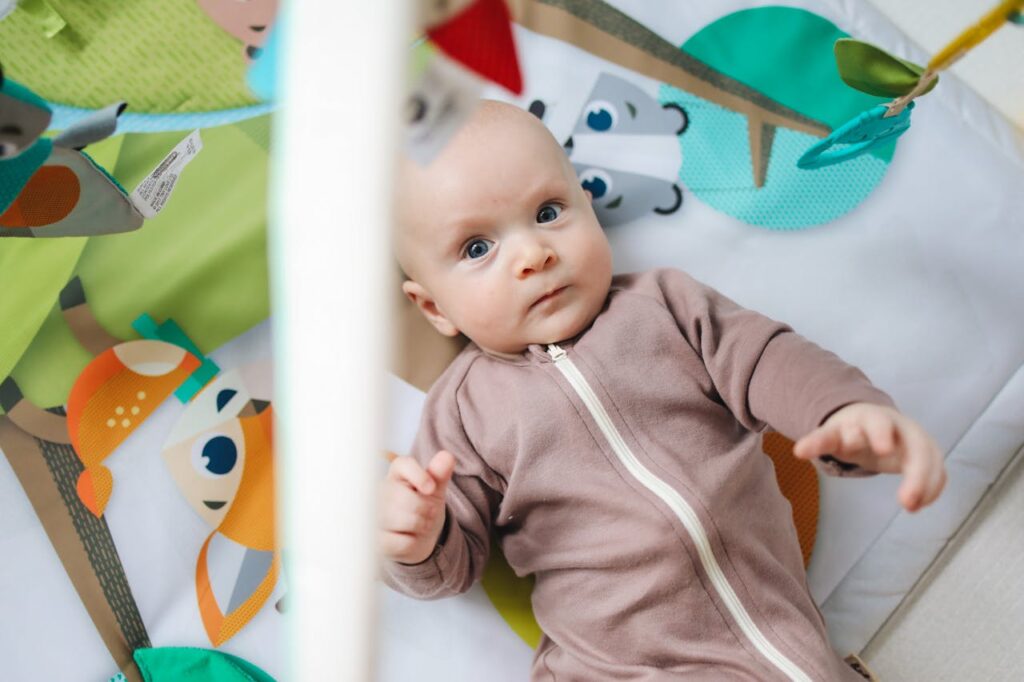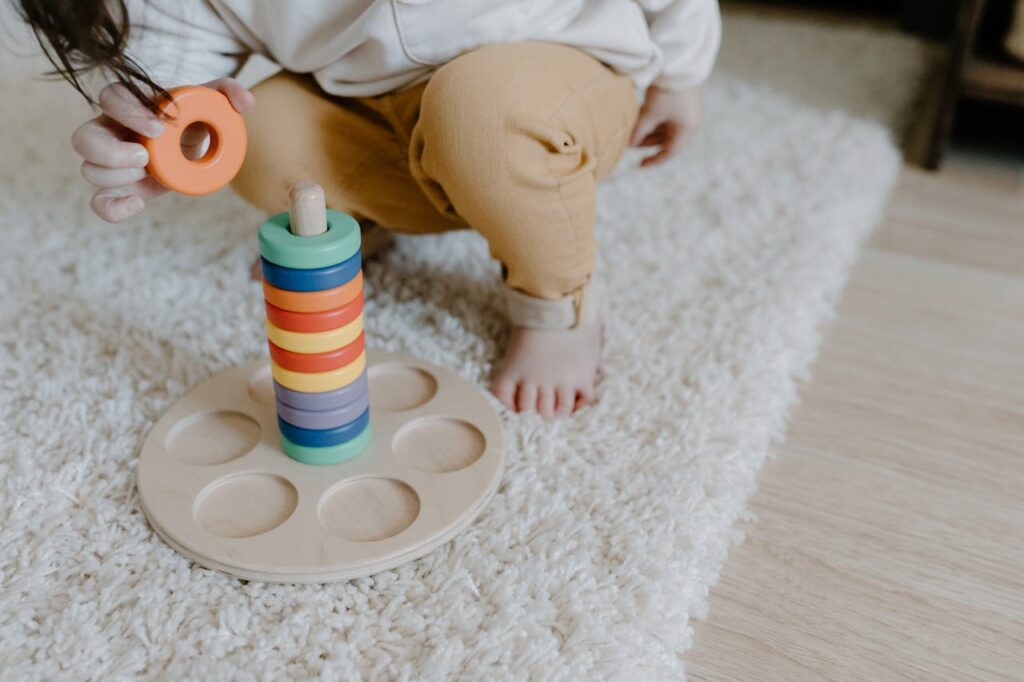Oh, baby! Sad to say I disliked being pregnant. From the all-day sickness to the swollen feet and the lack of energy most times, what’s not to love?
I can say what I did enjoy doing during my pregnancy was online shopping. After finding out the baby’s gender around the 5-month mark, I couldn’t hold back on scrapping through the internet for everything pretty and pink! My energy was picking up a bit in the second trimester and I felt at liberty to start shopping in anticipation of our little one.
I first did a deep dive into the world of thebump.com and babycenter app to compile a list of the essentials that I need in the first year of life.

What is a Baby Playmat?
After endless scrolling through Pinterest.com and reading mommy blogs one of those essentials that was consistently recommended was a baby playmat. Playmats are not just part of the decor in the nursery. These colorful baby playmats feature soft padding and interactive features, making them a great option for tummy time, playtime, and even nap time. They serve to provide an engaging play area and safe space for babies.
Although I was infatuated by the cuteness of the baby playmats, like most baby toys I had to consider the benefits and the shelf life to decide if its worth the purchase. So I decided to check “what age do babies stop using playmats”?. The answer was on average 8 to 9 months. I consider that to be quite a short time but in comparison the benefits of playmats. I quickly made the purchase.
What is the difference between a baby playmat and baby gym?
Both the baby playmat and baby gym have a lot of similarities but they are indeed different. The playmat is typically a large padded mat designed to create a safe space for play for babies on the floor. They typically come with toys to use during tummy time and can be easily folded and stored away when not in use.
A play gym typically has a free-standing frame or bar with hanging toys with a padded mat on the bottom.
Before we can start talking about the age at which a baby play mat is no longer needed, I will talk about when you need to start using one.
When do Babies start using playmats?
Playmats can be introduced to babies as early as newborn age. They provide a comfortable and soft surface for babies to lay on, making tummy time more enjoyable and helping to develop their neck muscle strength and upper body strength. As babies grow and become more mobile, playmats can provide a safe place to explore and play without the risk of injury from hard surfaces.
To be honest, I didn’t start using any of the baby play gym or activity mats until my little one was about 2 months of age. Even when I did start, I was using the playmat on the BED! Yes, I know silly me! But I couldn’t get over the anxiety of placing my baby on the ground. Do you know what causes more anxiety than putting baby on the ground, and leaving a wiggly baby on the bed? Trust me, do yourself and baby a favor and start using your baby play mat on the ground by 1 month old.
Once your little bundle of joy can lie flat on their back without being held you can use the mat. The American Academy of Pediatrics suggests 20 to 30 minutes of playmat time alternating between the back and tummy.
Benefits of Baby Playmats?
– One of the primary benefits of baby playmats is their ability to promote sensory development in babies. These mats are often designed with variety of textures, bright colors, and patterns that provide sensory stimulation and sensory exploration. By engaging with the different textures and colors on the playmat, babies can develop their sensory skills and learn to recognize different objects and shapes.
– In addition to promoting sensory development, baby playmats provide a safe and comfortable place for babies to play. Most playmats are made from soft, padded materials that offer cushioning for little ones as they crawl, roll, and play. This can help prevent injuries and provide a comfortable surface for babies to explore and play on.
– Baby playmats can also help promote tummy time, essential for a baby’s development. Tummy time helps strengthen a baby’s neck, shoulder, and core and shoulder muscles, which are crucial for motor development and overall physical strength. By placing a baby on a playmat for tummy time, parents can encourage their little one to engage in this important activity in a safe and comfortable environment.
– Baby playmats is that they are portable and easy to clean, making them a convenient option for busy parents. Many playmats are lightweight and can be easily rolled up or folded for storage or travel. Additionally, most playmats are made of fabric that can be wiped clean with a damp cloth and are machine washable, making them easy to maintain and keep clean for your little one.
– Some playmats function as a baby activity gym, with repositionable bars, interactive elements, and hanging mobiles. This a great way to encourage your little one to work on their hand-eye coordination and fine motor skills by using their grasping skills to grab dangling toys with different animals and colours.
– Playmats can help promote bonding between parents and babies. Spending time on the mat with their little ones, parents can interact and play with their babies in a safe and comfortable environment. This can create positive associations with playtime and help strengthen the parent-child relationship.
When should babies stop using playmats?
The simple answer is it depends on your little one!
I have spoken about the great benefits of baby playmats. As your little one progresses through her developmental stage, like with all toys it is important to know when to retire them. Most child development experts recommend that babies stop using playmats and play gyms once they start crawling or walking. This is usually around 6 to 9 months of age. At this point, babies are more mobile and need more space to explore and move around. Once your baby starts rolling, crawling, and sitting up independently, they may no longer be interested in lying on a playmat or playing under a play gym.
Some babies may continue to enjoy playing on a playmat or under a play gym for longer period. While others may quickly lose interest and is entertained for short periods of time. Parents need to observe their baby’s cues and provide them with play opportunities that are developmentally appropriate and stimulating. Playmats and play gyms are great for tummy time and help babies hand-eye coordination, cognitive development, gross and fine motor skills. They may become too limited for older babies who are eager to explore their surroundings and interact with more engaging toys.
If your baby is showing signs of boredom or frustration during playtime on a playmat or play gym, it may be time to introduce new toys and activities to keep them engaged. Look for toys that encourage reaching, grabbing, and exploring, such as soft blocks, rattles, and stacking toys.
Frequently Asked Questions
How long should a baby play on a playmat?
As mentioned before each baby is unique. So look for cues in your baby. A general rule to go by is 20 – 30 minutes of play on the mats rotating between time on back and on belly.
What age do babies grow out of play gym?
Babies typically outgrow play gyms at around 9 months of age. At this stage your little one will surely be crawling off the mat ready to explore the rest of the room.
Is playmat necessary for baby?
A playmat is a nursery essential, not just for aesthetics. It provides a safe environment for babies to play and explore while developing fine and gross motor skills.
Is it OK for baby to sleep on playmat?
If your baby has fallen asleep on the mat it is OK for them to stay there. Just ensure that you secure the environment from animals and keep an eye on them.
How many months do babies start playing?
Jean Piaget said, “Play is the work of children.”
As babies are born their work of play has began. Play is the medium through which they learn and get familiar with their environment and world.
Conclusion
Ultimately, the decision of when to stop using playmats and play gyms will depend on your baby’s individual needs and preferences. Playmats and play gyms are just one small part of your baby’s playtime routine. By observing your baby’s cues and providing them with different toys (preferably open-ended toys) and activities that support babies’ development, you can ensure that they continue to thrive and grow in a stimulating and engaging environment. Continuing to use playmats and play gyms past the recommended 9 months age may limit their movement and hinder their development.


